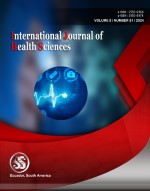Prevalence of thoracic outlet syndrome among patients visiting physical therapy outpatient department of public sector Tertiary Care Hospitals, Peshawar
Keywords:
Thoracic outlet syndroem, brachial plexus, subclavian artery, subclavian veinAbstract
The indications and symptoms in the upper extremity brought on by compression of the brachial plexus, subclavian vein, and/or subclavian artery at the thoracic outlet were originally referred to as thoracic outlet syndrome (TOS). The symptoms of neurogenic thoracic outlet syndrome (NTOS) are caused by compression of the brachial plexus roots as they travel through the thoracic outlet. The most typical symptom of thoracic outlet syndrome is neurogenic thoracic outlet syndrome (NTOS). The brachial plexus is compressed and irritated, which causes its symptoms.A cross-sectional study was conducted from March 2023 to June 2023 among patients visiting Physical therapy outpatient department of public sector tertiary care hospitals Peshawar. The DASH questionnaire was distributed to all patients according to inclusion criteria from different hospitals to collect data on the prevalence of thoracic outlet syndrome.The study found that the prevalence of thoracic outlet syndrome was higher in female. The prevalence was higher among female housewives (77.77%) compared to male (63%). Risk factors associated with this pain included improper posture in same position while working, long work durations, repetitive tasks, and restricted neck movements.
Downloads
References
Arellano, K. (2021). "Thoracic outlet Syndrome Decompression and the Effect of Physical Therapy in the Outpatient Setting: A Case Study.
Balderman, J., et al. (2019). "Physical therapy management, surgical treatment, and patient-reported outcomes measures in a prospective observational cohort of patients with neurogenic thoracic outlet syndrome." Journal of vascular surgery 70(3): 832-841. DOI: https://doi.org/10.1016/j.jvs.2018.12.027
Camporese, G., et al. (2022). "Diagnostic and therapeutic management of the thoracic outlet syndrome. Review of the literature and report of an Italian experience." Frontiers in Cardiovascular Medicine 9: 802183. DOI: https://doi.org/10.3389/fcvm.2022.802183
Daley, P., et al. (2022). "Use of Electroneuromyography in the Diagnosis of Neurogenic Thoracic Outlet Syndrome: A Systematic Review and Meta-Analysis." Journal of Clinical Medicine 11(17): 5206. DOI: https://doi.org/10.3390/jcm11175206
Iftikhar, S., et al. (2020). "The Prevalence of Cervical Rib found during chest Radiography in the Population of Khyber Pakhtunkhwa, Pakistan." Advances in Basic Medical Sciences 4(1).
Kaczmarek, A. M., et al. (2022). "Relationships between the Clinical Test Results and Neurophysiological Findings in Patients with Thoracic Outlet Syndrome." Bioengineering 9(10): 598. DOI: https://doi.org/10.3390/bioengineering9100598
Kc, S., et al. (2019). "Cross-cultural adaptation and measurement properties of the Nepali version of the DASH (disability of arm, shoulder and hand) in patients with shoulder pain." Health and Quality of life Outcomes 17(1): 1-10. DOI: https://doi.org/10.1186/s12955-019-1105-1
Masocatto, N. O., et al. (2019). "Thoracic outlet syndrome: a narrative review." Revista do ColégioBrasileiro de Cirurgiões 46.
Masocatto, N. O., et al. (2019). "Thoracic outlet syndrome: a narrative review." Revista do ColégioBrasileiro de Cirurgiões 46. DOI: https://doi.org/10.1590/0100-6991e-20192243
Nuutinen, H., et al. (2022). "Long-term outcomes of transaxillary versus video-assisted first rib resection for neurogenic thoracic outlet syndrome." Interactive CardioVascular and Thoracic Surgery 35(1): ivac040. DOI: https://doi.org/10.1093/icvts/ivac040
Ohman, J. W. and R. W. Thompson (2020). "Thoracic outlet syndrome in the overhead athlete: diagnosis and treatment recommendations." Current Reviews in Musculoskeletal Medicine 13: 457-471. DOI: https://doi.org/10.1007/s12178-020-09643-x
Published
How to Cite
Issue
Section
Copyright (c) 2024 International journal of health sciences

This work is licensed under a Creative Commons Attribution-NonCommercial-NoDerivatives 4.0 International License.
Articles published in the International Journal of Health Sciences (IJHS) are available under Creative Commons Attribution Non-Commercial No Derivatives Licence (CC BY-NC-ND 4.0). Authors retain copyright in their work and grant IJHS right of first publication under CC BY-NC-ND 4.0. Users have the right to read, download, copy, distribute, print, search, or link to the full texts of articles in this journal, and to use them for any other lawful purpose.
Articles published in IJHS can be copied, communicated and shared in their published form for non-commercial purposes provided full attribution is given to the author and the journal. Authors are able to enter into separate, additional contractual arrangements for the non-exclusive distribution of the journal's published version of the work (e.g., post it to an institutional repository or publish it in a book), with an acknowledgment of its initial publication in this journal.
This copyright notice applies to articles published in IJHS volumes 4 onwards. Please read about the copyright notices for previous volumes under Journal History.
















